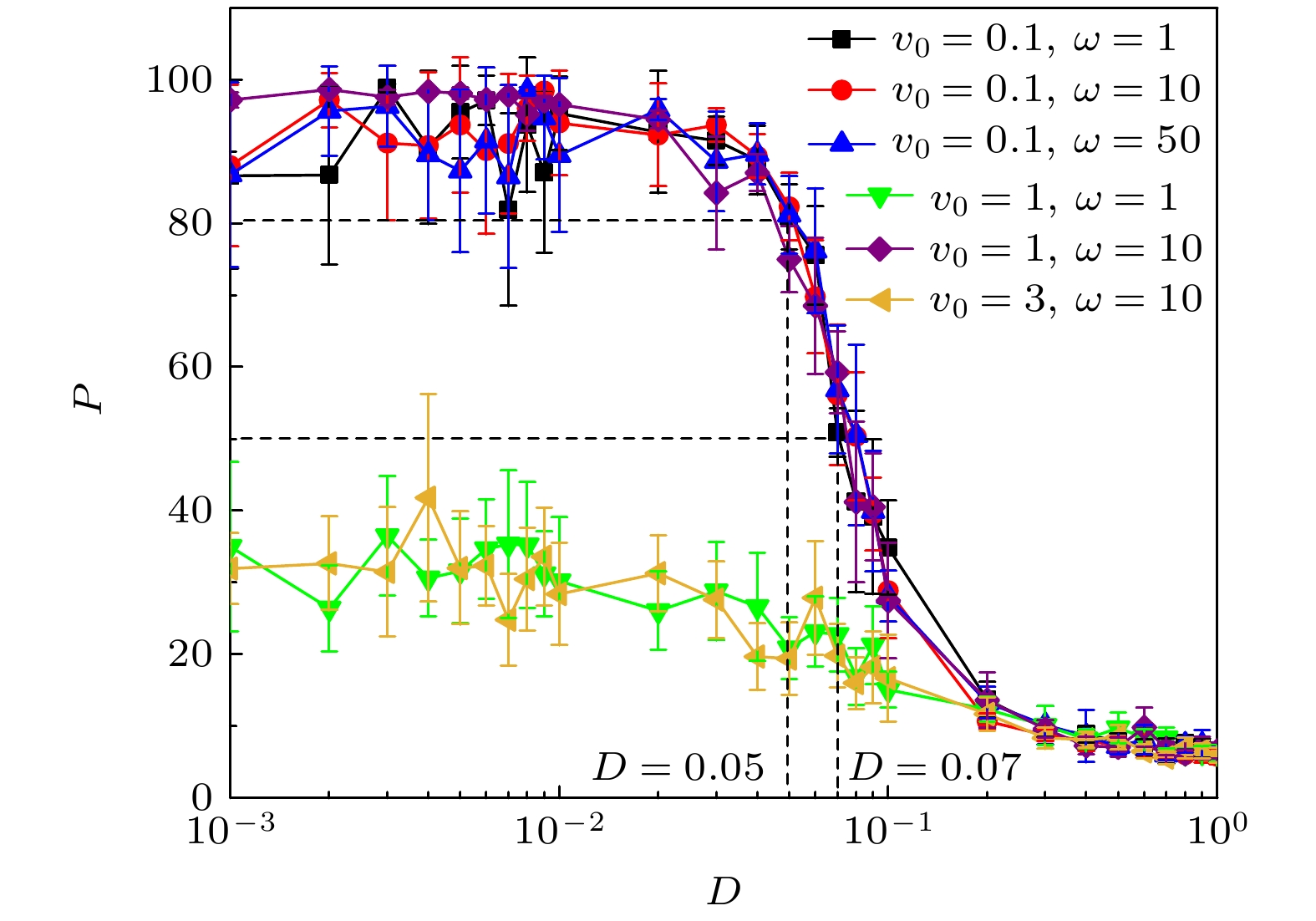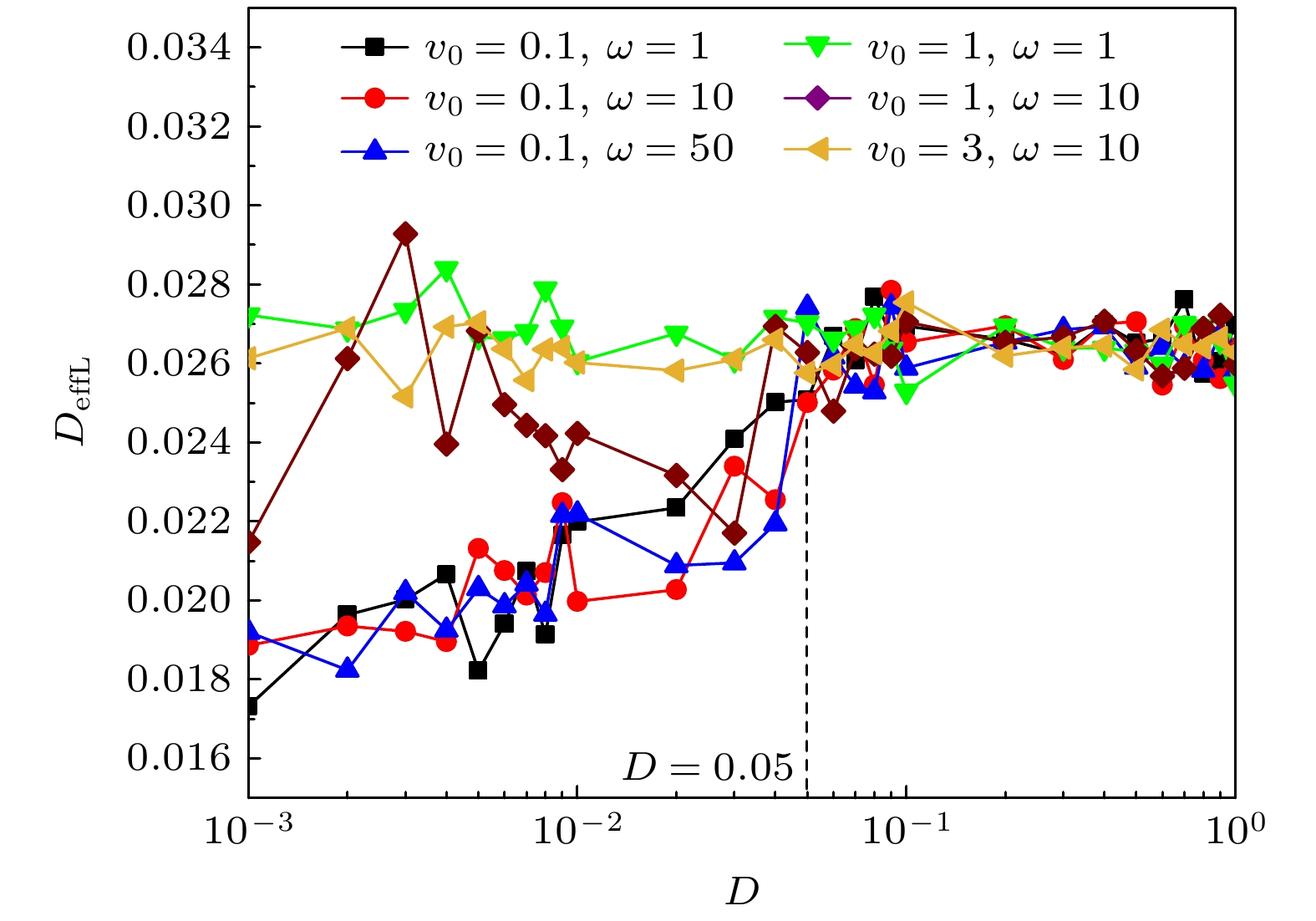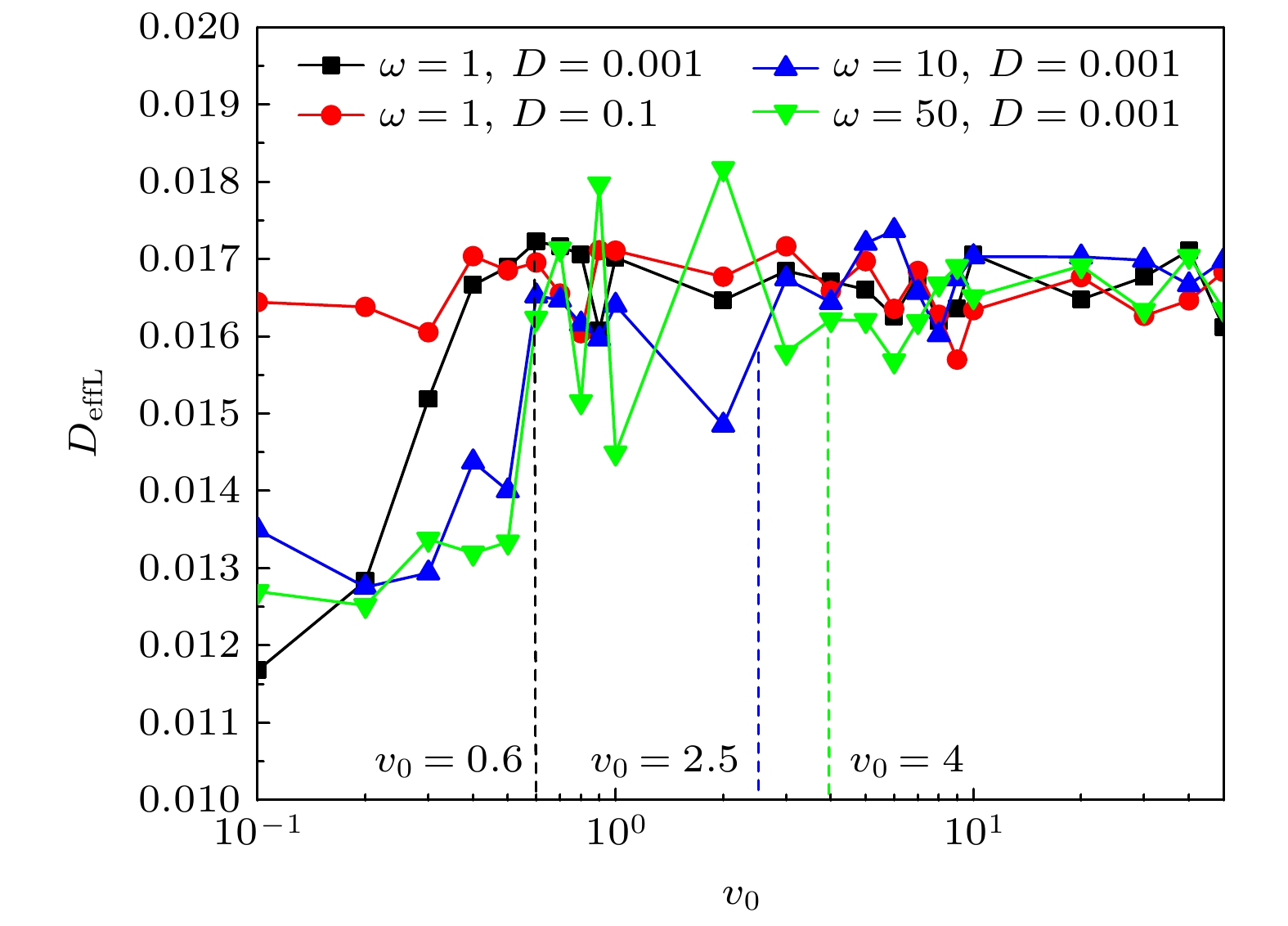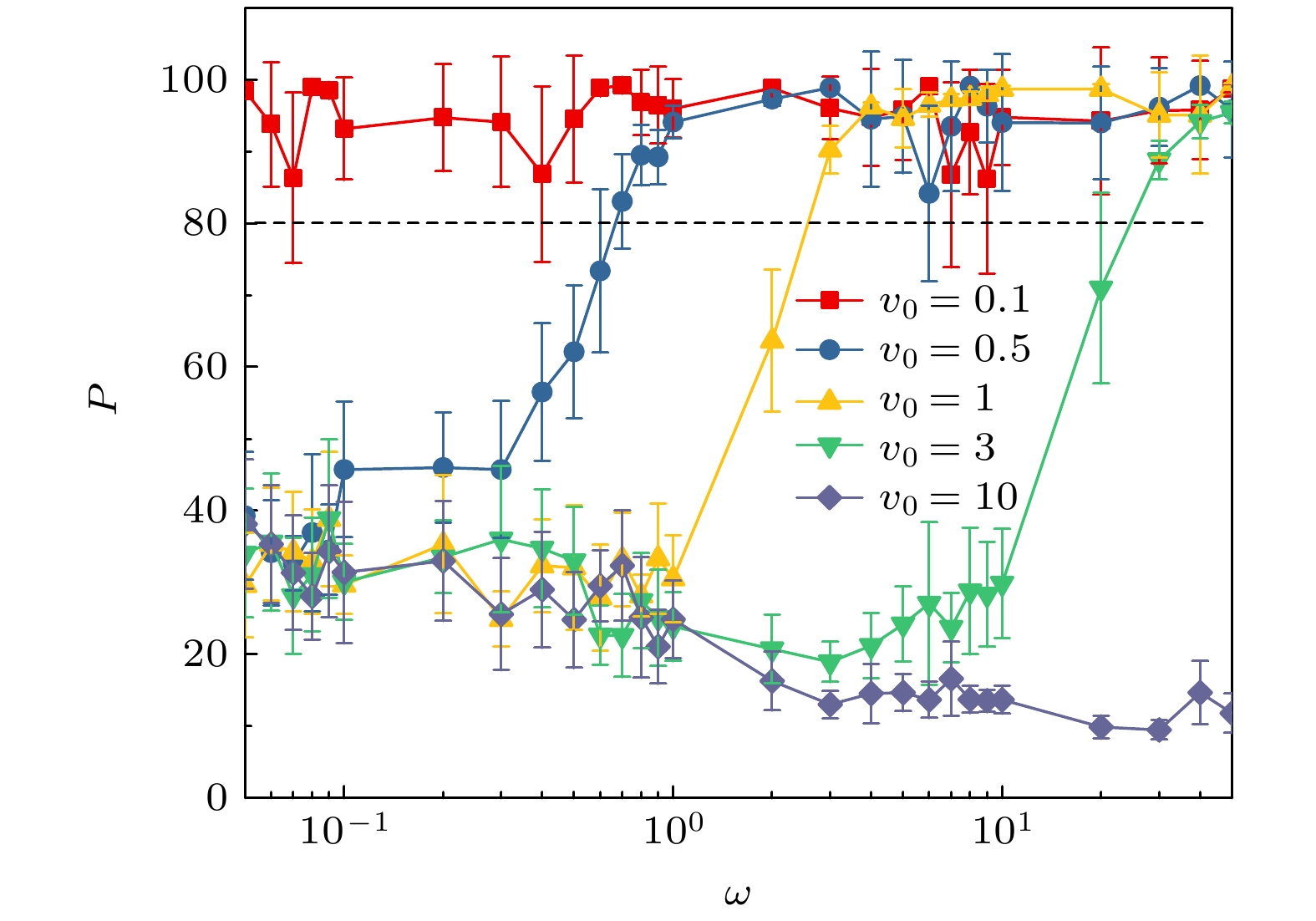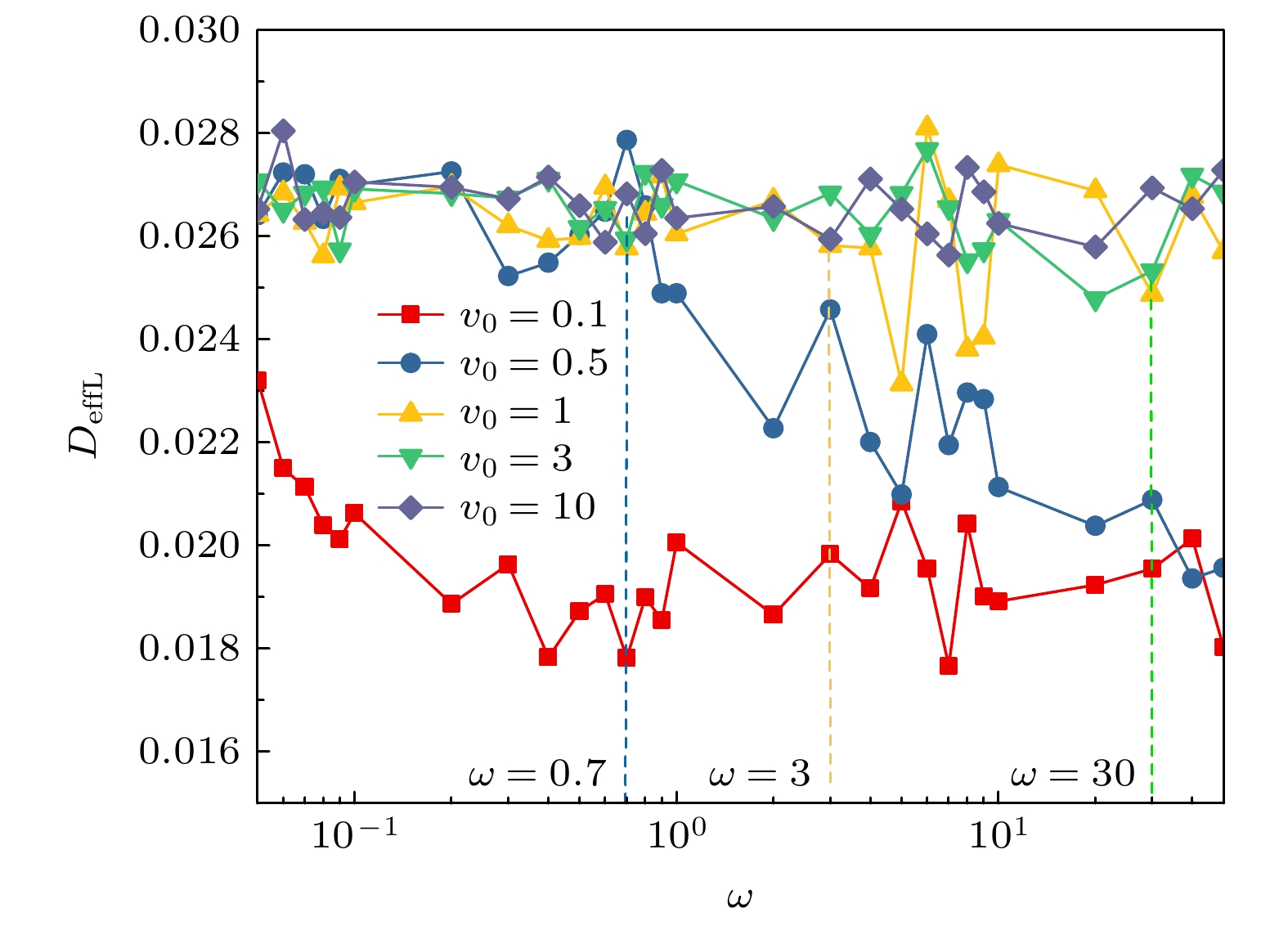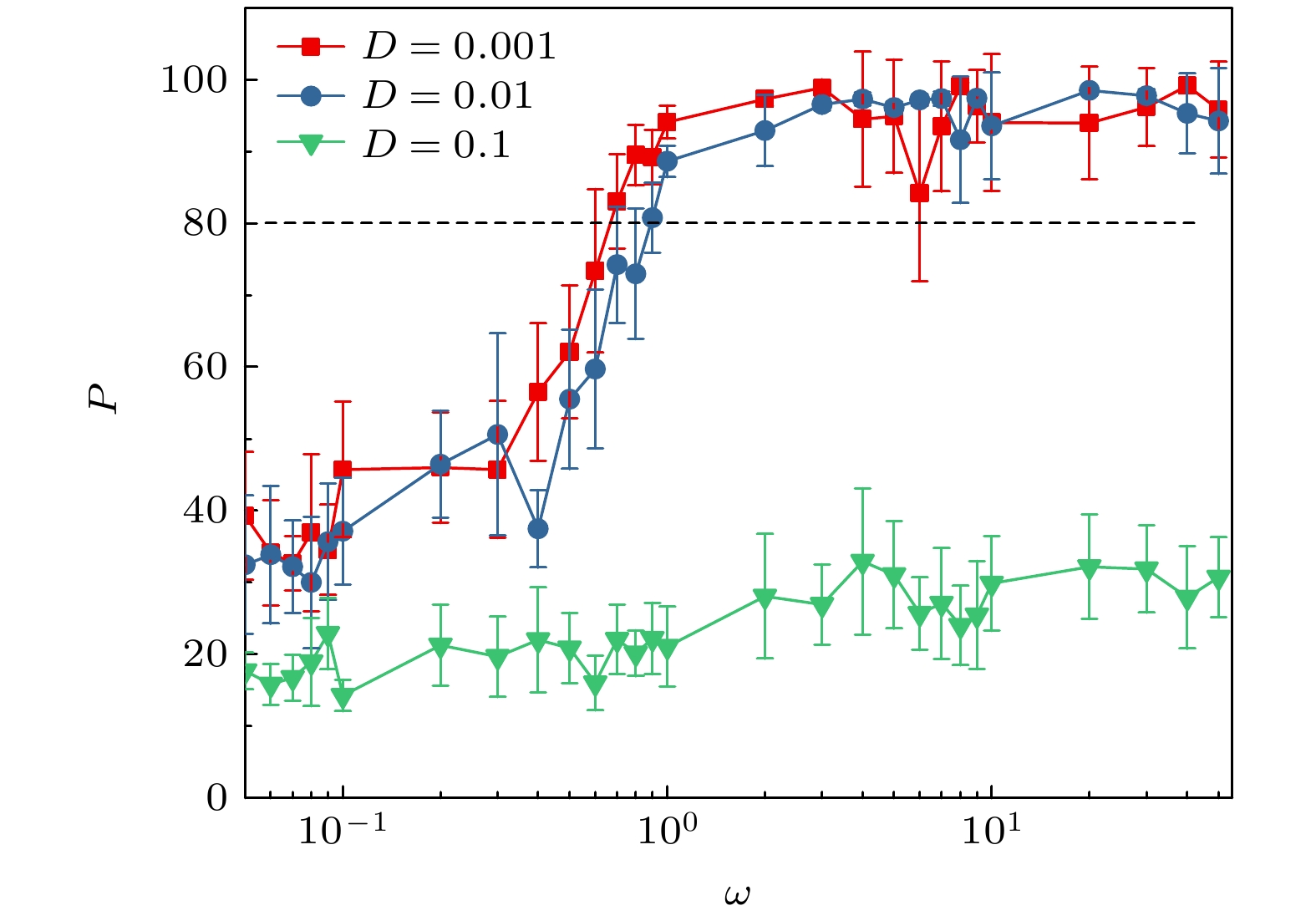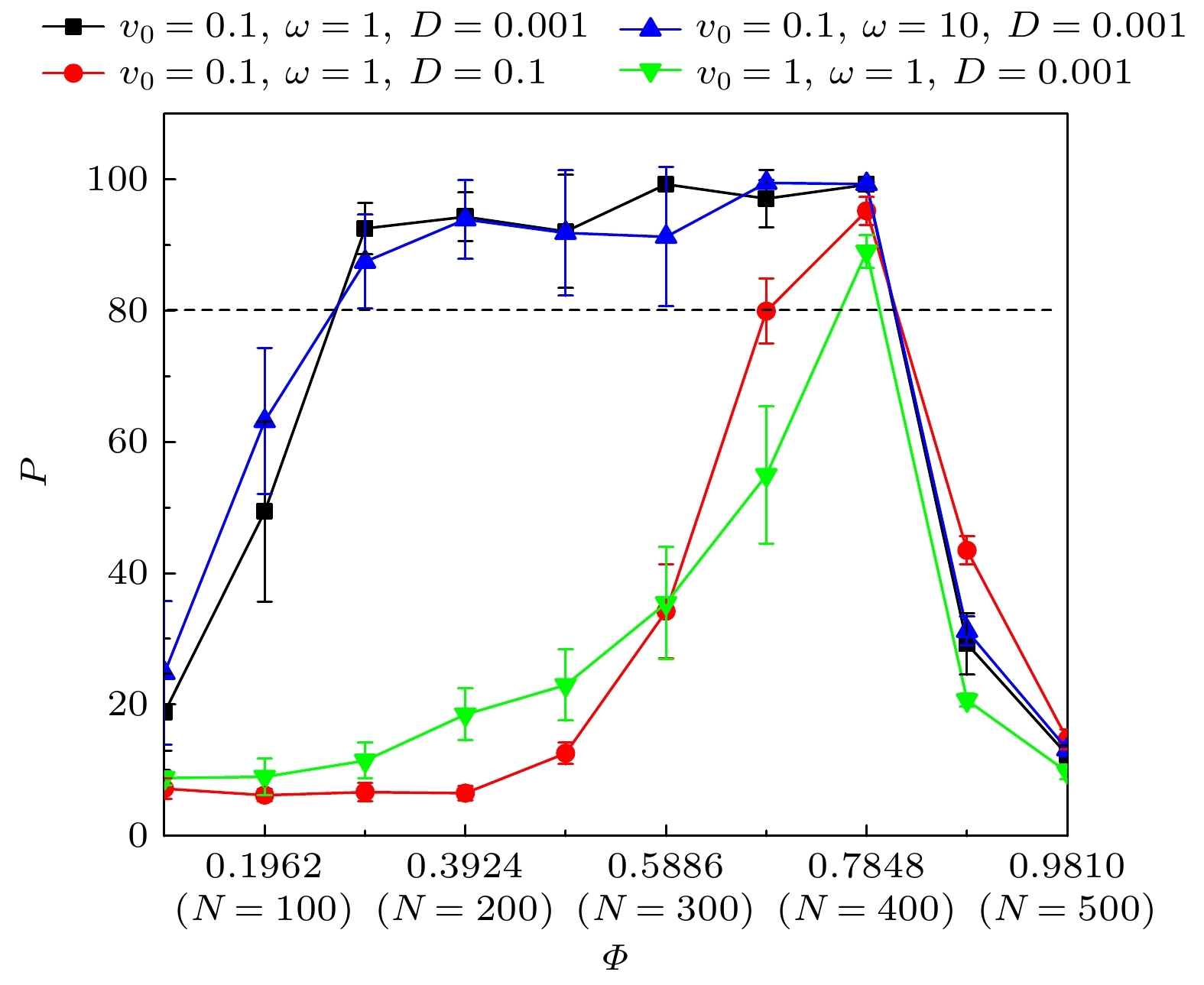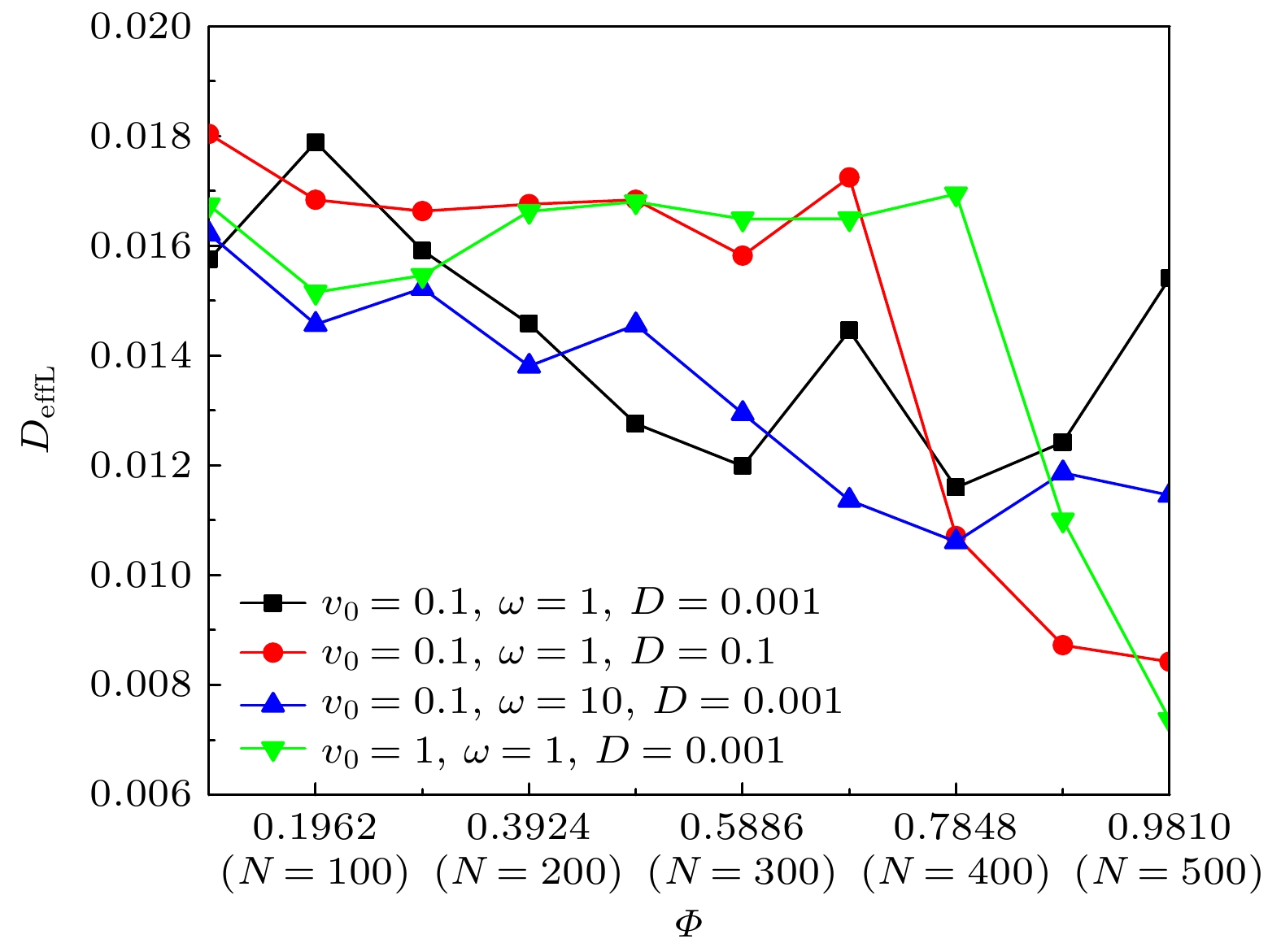-
近几年对活性粒子的研究已成为很多领域研究者关注的重要课题之一, 其中关于活性手征粒子的相分离问题具有重要的理论和实际意义. 本文通过朗之万动力学研究了具有不同扩散系数的活性手征粒子组成的二元混合系统中粒子的相分离. 较小的相对扩散系数有利于“冷”粒子形成大的团簇而分离, 较大的相对扩散系数则会减弱分离效果. 由于粒子特征(自驱动速度、自转角速度)和相对扩散系数对粒子间碰撞作用的影响, 系统要使“冷”“热”粒子达到相分离, 自驱动速度和自转角速度的增大(或减小)不能同步, 自驱动速度的相对变化率要小于自转角速度的相对变化率. 通过分析“冷”粒子有效扩散系数的变化, 系统相分离现象得到了很好的解释. 有效扩散系数较小意味着“冷”粒子会聚集形成较大的团簇, 系统可出现相分离现象, 而当有效扩散系数较大时“冷”粒子的扩散较强, 不会形成大的团簇产生相分离. 另外, 随着粒子填充率的增大“冷”粒子最大团簇粒子数占比曲线进行先增大后减小的非单调变化, 每条曲线存在一段最优粒子填充率宽度. 相对扩散系数和自驱动速度的增大, 会使曲线的最优填充率宽度变窄并向右偏移.In recent years, the study of active particles has become one of the important topics concerned by researchers in many fields, among which the phase separation of active chiral particles has important theoretical and practical significance. In this paper, the phase separation of binary mixed systems composed of active chiral particles with different diffusion coefficients is studied by Langevin dynamics. A smaller relative diffusion coefficient is conducive to the formation of large clusters and the separation of “cold” particles, while a larger relative diffusion coefficient will weaken the separation effect. Due to the influence of particle characteristics (self-driven velocity, self-rotational angular velocity) and relative diffusion coefficient on the collision between particles, if one wants the “cold” and “hot” particles to reach phase separation, increasing (or reducing) the self-driven velocity and self-rotational angular velocity cannot be synchronous, and the relative rate of change of self-driven velocity is smaller than that of the self-rotational angular velocity. By analyzing the changes of the effective diffusion coefficient of “cold” particles, the phenomenon of phase separation in the system can be better explained. A smaller effective diffusion coefficient means that the “cold” particles will aggregate into larger clusters, and the system may exhibit phase separation. However, when the effective diffusion coefficient is larger, the diffusion of “cold” particles is stronger and the “cold” particles will not form large clusters, which means that the system cannot aggregate into phase separation. In addition, with the filling rate of particle increasing, the proportion curve of the number of cold particles in maximum cold particle cluster undergoes a non-monotonic change, specifically, it first increases and then decreases. Each curve has an optimal filling rate but its width is different .With the increase of the relative diffusion coefficient and self-driven velocity, the width of the optimal filling rate of the proportion curve will become narrower and shift toward the right.
-
Keywords:
- active particles /
- chirality /
- Langevin equation /
- diffusion coefficient
[1] Ramaswamy S 2010 Ann. Rev. Condens. Matt. Phys. 1 323
 Google Scholar
Google Scholar
[2] Howse J S, Ebbens S J 2010 Soft Matter 6 726
 Google Scholar
Google Scholar
[3] Lobaskin V, Romenskyy M 2013 Phys. Rev. E 87 052135
 Google Scholar
Google Scholar
[4] Edwards A M, Phillips R A, Watkins N W, Freeman M P, Murphy E J, Afanasyev V, Buldyrev S V, da Luz M G, Raposo E P, Stanley H E, Viswanathan G M 2007 Nature 449 1044
 Google Scholar
Google Scholar
[5] Brambilla M, Ferrante E, Birattari M, Dorigo M 2013 Swarm Intelligence 7 1
 Google Scholar
Google Scholar
[6] Helbing D 2001 Rev. Mod. Phys. 73 1067
 Google Scholar
Google Scholar
[7] Marchetti M C, Joanny J F, Ramaswamy S, Liverpool T B, Prost J, Rao M, Simha R A 2013 Rev. Mod. Phys. 85 1143
 Google Scholar
Google Scholar
[8] Wang J, Gao W 2012 ACS Nano 6 5745
 Google Scholar
Google Scholar
[9] Chen C, Liu S, Shi X Q, Chaté H, Wu Y 2017 Nature 542 210
 Google Scholar
Google Scholar
[10] Berg H C 2003 Biochem 72 19
[11] Berg H C 2004 Ecoli in Motion (New York: Springer Press) pp39–47
[12] Nishiguchi D, Sano M 2015 Phys. Rev. E 92 052309
[13] Ma X, Hahn K, Sanchez S 2015 J. Am. Chem. Soc. 137 4976
 Google Scholar
Google Scholar
[14] Li J, Singh V V, Sattayasamitsathit S, Orozco J, Kaufmann K, Dong R, Gao W, Jurado-Sanchez B, Fedorak Y, Wang J 2014 ACS Nano 8 11118
 Google Scholar
Google Scholar
[15] Abdelmohsen L K, Peng F, Tu Y, Wilson D A 2014 J. Mater. Chem. B 2 2395
 Google Scholar
Google Scholar
[16] Vlope G, Gigan S, Volpe G 2014 Am. J. Phys. 82 659
 Google Scholar
Google Scholar
[17] Bechinger C, Di Leonardo R, Löwen H, Reichhardt C, Volpe G, Volpe G 2016 Rev. Mod. Phys. 88 045006
 Google Scholar
Google Scholar
[18] Ai B Q, Shao Z G, Zhong W R 2018 soft matter 14 4388
 Google Scholar
Google Scholar
[19] 张何朋, 施夏清, 杨明成 2022 物理 51 217
 Google Scholar
Google Scholar
Zhang H P, Shi X Q, Yang M C 2022 Physics 51 217
 Google Scholar
Google Scholar
[20] Cates M E, Tailleur J 2015 Annu. Rev. Condens. Matter Phys. 6 219
 Google Scholar
Google Scholar
[21] Fily Y, Marchetti M C 2012 Phys. Rev. Lett. 108 235702
 Google Scholar
Google Scholar
[22] Redner G S, Hagan M F, Baskaran A 2013 Biophys. J. 104 640a
 Google Scholar
Google Scholar
[23] Speck T, Bialké J, Menzel A M, Löwen H 2014 Phys. Rev. Lett. 112 218304
 Google Scholar
Google Scholar
[24] 夏益祺, 谌庄琳, 郭永坤 2019 物理学报 68 161101
 Google Scholar
Google Scholar
Xia Y Q, Shen Z L, Guo Y K 2019 Acta Phys. Sin. 68 161101
 Google Scholar
Google Scholar
[25] Kaiser A, Popowa K, Wensink H H, Lowen H 2013 Phys. Rev. E 88 022311
 Google Scholar
Google Scholar
[26] Wan M B, Reichhardt C O, Nussinov Z, Reichhardt C 2008 Phys. Rev. Lett. 101 018102
 Google Scholar
Google Scholar
[27] Ahuja S 2011 Chiral Separation Methods for Pharmaceutical and Biotechnological Products (Hoboken: John Wiley and Sons Press) p131
[28] Wu J C, Dong T W, Jiang G W, An M, Ai B Q 2020 J. Chem. Phys. 152 034901
 Google Scholar
Google Scholar
[29] 廖晶晶, 蔺福军 2020 物理学报 69 220501
 Google Scholar
Google Scholar
Liao J J, Lin F J 2020 Acta Phys. Sin. 69 220501
 Google Scholar
Google Scholar
[30] Kümmel F P, Shabestari P, Lozano C, Volpe G, Bechinger C 2015 Soft Matter 11 6187
 Google Scholar
Google Scholar
[31] Zhu W J, Li T C, Zhong W R, Ai B Q 2020 J. Chem. Phys. 152 1849031
[32] Weber S N, Weber C A, Frey E 2016 Phys. Rev. Lett. 116 058301
 Google Scholar
Google Scholar
[33] Kumari S, Nunes A S, Araújo N A, Telo da Gama M M 2017 J. Chem. Phys. 147 174702
 Google Scholar
Google Scholar
[34] Ai B Q 2017 Phys. Rev. E 96 012131
 Google Scholar
Google Scholar
-
图 1 三种不同系统中粒子的相分离(Ncold = Nhot = N/2 = 150, D = DTL/DTH = 0.001) (a)被动粒子系统(v0 = 0, ω = 0); (b)自驱动粒子系统(v0 = 0.1, ω = 0); (c)自驱动粒子系统(v0 = 1, ω = 0); (d)活性手征粒子系统(v0 = 1, ω = 10)
Fig. 1. Phase separation of particles in three different systems (Ncold = Nhot = N/2 = 150, D = DTL/DTH = 0.001): (a) The system of passive particles (v0 = 0, ω = 0); (b) the system of self-driven particles (v0 = 0.1, ω = 0); (c) the system of self-driven particles (v0 = 1, ω = 0); (d) the system of active chiral particles (v0 = 1, ω = 10).
-
[1] Ramaswamy S 2010 Ann. Rev. Condens. Matt. Phys. 1 323
 Google Scholar
Google Scholar
[2] Howse J S, Ebbens S J 2010 Soft Matter 6 726
 Google Scholar
Google Scholar
[3] Lobaskin V, Romenskyy M 2013 Phys. Rev. E 87 052135
 Google Scholar
Google Scholar
[4] Edwards A M, Phillips R A, Watkins N W, Freeman M P, Murphy E J, Afanasyev V, Buldyrev S V, da Luz M G, Raposo E P, Stanley H E, Viswanathan G M 2007 Nature 449 1044
 Google Scholar
Google Scholar
[5] Brambilla M, Ferrante E, Birattari M, Dorigo M 2013 Swarm Intelligence 7 1
 Google Scholar
Google Scholar
[6] Helbing D 2001 Rev. Mod. Phys. 73 1067
 Google Scholar
Google Scholar
[7] Marchetti M C, Joanny J F, Ramaswamy S, Liverpool T B, Prost J, Rao M, Simha R A 2013 Rev. Mod. Phys. 85 1143
 Google Scholar
Google Scholar
[8] Wang J, Gao W 2012 ACS Nano 6 5745
 Google Scholar
Google Scholar
[9] Chen C, Liu S, Shi X Q, Chaté H, Wu Y 2017 Nature 542 210
 Google Scholar
Google Scholar
[10] Berg H C 2003 Biochem 72 19
[11] Berg H C 2004 Ecoli in Motion (New York: Springer Press) pp39–47
[12] Nishiguchi D, Sano M 2015 Phys. Rev. E 92 052309
[13] Ma X, Hahn K, Sanchez S 2015 J. Am. Chem. Soc. 137 4976
 Google Scholar
Google Scholar
[14] Li J, Singh V V, Sattayasamitsathit S, Orozco J, Kaufmann K, Dong R, Gao W, Jurado-Sanchez B, Fedorak Y, Wang J 2014 ACS Nano 8 11118
 Google Scholar
Google Scholar
[15] Abdelmohsen L K, Peng F, Tu Y, Wilson D A 2014 J. Mater. Chem. B 2 2395
 Google Scholar
Google Scholar
[16] Vlope G, Gigan S, Volpe G 2014 Am. J. Phys. 82 659
 Google Scholar
Google Scholar
[17] Bechinger C, Di Leonardo R, Löwen H, Reichhardt C, Volpe G, Volpe G 2016 Rev. Mod. Phys. 88 045006
 Google Scholar
Google Scholar
[18] Ai B Q, Shao Z G, Zhong W R 2018 soft matter 14 4388
 Google Scholar
Google Scholar
[19] 张何朋, 施夏清, 杨明成 2022 物理 51 217
 Google Scholar
Google Scholar
Zhang H P, Shi X Q, Yang M C 2022 Physics 51 217
 Google Scholar
Google Scholar
[20] Cates M E, Tailleur J 2015 Annu. Rev. Condens. Matter Phys. 6 219
 Google Scholar
Google Scholar
[21] Fily Y, Marchetti M C 2012 Phys. Rev. Lett. 108 235702
 Google Scholar
Google Scholar
[22] Redner G S, Hagan M F, Baskaran A 2013 Biophys. J. 104 640a
 Google Scholar
Google Scholar
[23] Speck T, Bialké J, Menzel A M, Löwen H 2014 Phys. Rev. Lett. 112 218304
 Google Scholar
Google Scholar
[24] 夏益祺, 谌庄琳, 郭永坤 2019 物理学报 68 161101
 Google Scholar
Google Scholar
Xia Y Q, Shen Z L, Guo Y K 2019 Acta Phys. Sin. 68 161101
 Google Scholar
Google Scholar
[25] Kaiser A, Popowa K, Wensink H H, Lowen H 2013 Phys. Rev. E 88 022311
 Google Scholar
Google Scholar
[26] Wan M B, Reichhardt C O, Nussinov Z, Reichhardt C 2008 Phys. Rev. Lett. 101 018102
 Google Scholar
Google Scholar
[27] Ahuja S 2011 Chiral Separation Methods for Pharmaceutical and Biotechnological Products (Hoboken: John Wiley and Sons Press) p131
[28] Wu J C, Dong T W, Jiang G W, An M, Ai B Q 2020 J. Chem. Phys. 152 034901
 Google Scholar
Google Scholar
[29] 廖晶晶, 蔺福军 2020 物理学报 69 220501
 Google Scholar
Google Scholar
Liao J J, Lin F J 2020 Acta Phys. Sin. 69 220501
 Google Scholar
Google Scholar
[30] Kümmel F P, Shabestari P, Lozano C, Volpe G, Bechinger C 2015 Soft Matter 11 6187
 Google Scholar
Google Scholar
[31] Zhu W J, Li T C, Zhong W R, Ai B Q 2020 J. Chem. Phys. 152 1849031
[32] Weber S N, Weber C A, Frey E 2016 Phys. Rev. Lett. 116 058301
 Google Scholar
Google Scholar
[33] Kumari S, Nunes A S, Araújo N A, Telo da Gama M M 2017 J. Chem. Phys. 147 174702
 Google Scholar
Google Scholar
[34] Ai B Q 2017 Phys. Rev. E 96 012131
 Google Scholar
Google Scholar
计量
- 文章访问数: 4200
- PDF下载量: 112
- 被引次数: 0













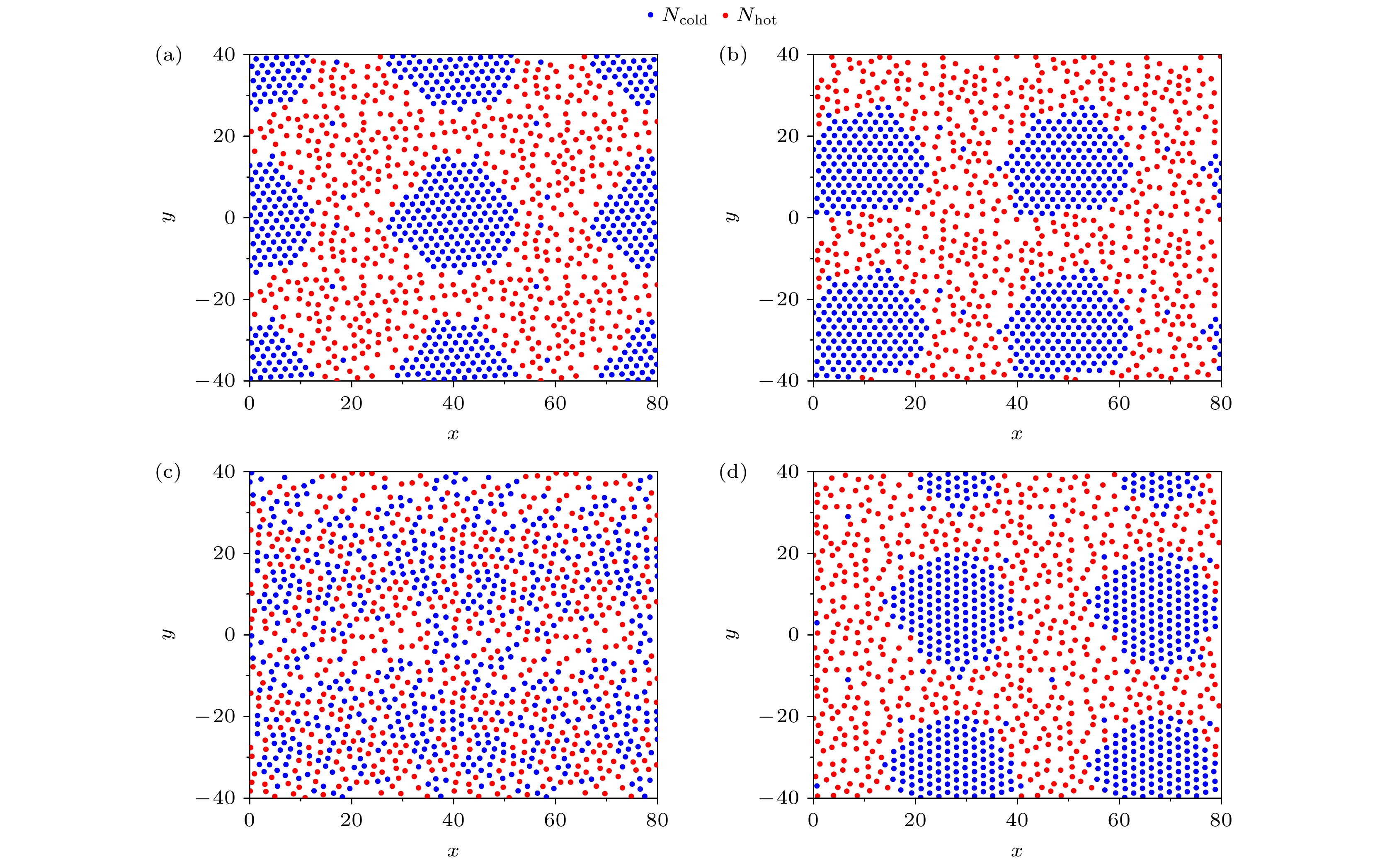
 下载:
下载:
